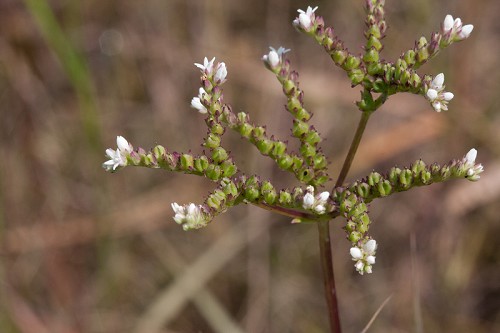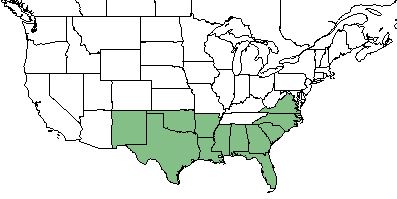Mitreola sessilifolia
Common name: swamp hornpod [1], small-leaved miterwort [2]
| Mitreola sessilifolia | |
|---|---|

| |
| Photo from the Southeastern Flora Database | |
| Scientific classification | |
| Kingdom: | Plantae |
| Division: | Magnoliophyta - Flowering plants |
| Class: | Magnoliopsida - Dicots |
| Order: | Gentianales |
| Family: | Loganiaceae |
| Genus: | Mitreola |
| Species: | M. sessilifolia |
| Binomial name | |
| Mitreola sessilifolia J.F. Gmelin | |

| |
| Natural range of Mitreola sessilifolia from USDA NRCS Plants Database. | |
Contents
Taxonomic Notes
Synonyms: Cynoctonum sessilifolium J.F. Gmelin
Varieties: none
Description
M sessilifolia is an annual forb/herb of the Loganiaceae family native to North America. [1]
Distribution
M. sessilifolia is found along the southeastern coast of the United States from New Mexico to Virginia. [1]
Ecology
Habitat
M. sessilifolia is found in wet savannas, pocosins, ditches, and margins of limesink depressions (dolines). [2] Specimens have been collected from moist loamy sand, wet ditches, oak woods, pine flatwoods, border of swampy woodland, longleaf pine wiregrass, savanna, sandy peat of slash pine, floodplain marsh, shore of sinkhole pond, wet pineland, frequently burned hillside of seepage bogs, pine-gum woodland, and along streams.[3] M. sessilifolia responds negatively or not at all to soil disturbance by roller chopping in South Florida.[4]
Mitreola sessilifolia is an indicator species for the Calcareous Savannas community type as described in Carr et al. (2010).[5]
Phenology
M. sessilifloria has been observed flowering in June, July, and September. [6]
Conservation and Management
Cultivation and restoration
Photo Gallery
References and notes
- ↑ 1.0 1.1 1.2 USDA Plant Database https://plants.usda.gov/core/profile?symbol=MISE3
- ↑ 2.0 2.1 Weakley, A. S. (2015). Flora of the Southern and Mid-Atlantic States. Chapel Hill, NC, University of North Carolina Herbarium.
- ↑ URL: http://herbarium.bio.fsu.edu. Last accessed: June 2018. Collectors: Loran C. Anderson, R.A> Norris, R.F. Doren, R.K. Godfrey, R. Komarek, Cecil Slaughter, S.W. Leonard, R.E. Perdue, R. Kral, Victoria Sullivan, Richard Houk, Robert J. Lamaire, George R. Cooley, Carroll E. Wood Jr., Kenneth A. Wilson, Leonard J. Brass, Steve Orzell, Edwin L. Bridges, James D. Ray, Sidney McDaniel, S.B. Jones, A.B. Seymour, D.S. Correll, E. C. Ogden, H.K. Svenson, A.E. Radford, P. Sheridan, Jeffery M. Kane, William Platt. States and counties: Florida (Liberty, Leon, Franklin, Santa Rosa, Flagler, Monroe, Jefferson, Levy, Brevard, Okaloosa, Orange, Bay, Palm Beach, St. Johns, Okeechobee, Indian River, Citrus, Calhoun, COllier, Gulf, Walton, Okaloosa, Martin, Lee, Nassau, Holmes) Georgia (Thomas, Grady, Berrien, Tattnall, Baker, Colquitt) Alabama (Mobile, Washington, Monroe) Mississippi (Lamar, Greene, Jackson, George) North Carolina (Onslow) South Carolina (Williamsburg) Texas (Jasper, Hardin)
- ↑ Lewis, C.E. (1970). Responses to Chopping and Rock Phosphate on South Florida Ranges. Journal of Range Management 23(4):276-282.
- ↑ Carr, S.C., K.M. Robertson, and R.K. Peet. 2010. A vegetation classification of fire-dependent pinelands of Florida. Castanea 75:153-189.
- ↑ Nelson, G. PanFlora: Plant data for the eastern United States with emphasis on the Southeastern Coastal Plains, Florida, and the Florida Panhandle. www.gilnelson.com/PanFlora/ Accessed: 24 MAY 2018